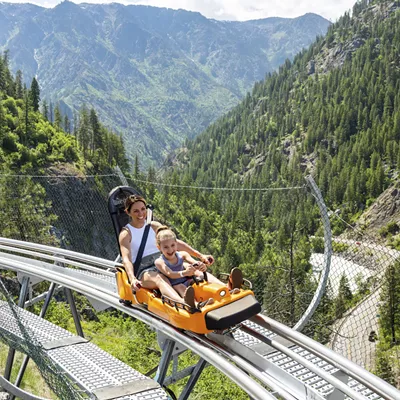It's a warm, dry June afternoon as 13 students, a biologist and I stand on the edge of the deepest river gorge in North America, Hells Canyon, and stare in. The students are silent. Awestruck. The canyon is a surprise to them. All week we have been on the Zumwalt Prairie — acres and acres of rolling hills. Vast open land that seemed only to end when it met the Seven Devils to the East.
This is why I have brought them here to Idaho's western edge. I want them to have a different vantage. I explain this to the students — that I want them to consider what lies hidden, beyond what they see on the surface of the land. What happens when we question the maps that have been drawn for us, the legislation created, the boundaries that define our understanding of place? I leave them to their writing and contemplation, and I walk back to the interpretive sign some government agency has placed at the overlook.
The interpretive sign is scarred and sun-bleached, its surface cracked and sharp like the canyon walls it overlooks. Beneath the jaundiced plastic, a romanticized picture emerges: granite-faced cowboys herding cattle upward through the canyon to the prairie. The accompanying text, taken from the journal of one of the cowboys, mourns a "lost way of life" as the cattle vanish into an undefined future. And there, almost hidden in the corner, a solitary pictograph clings to the canyon wall — a silent witness to millennia of Indigenous presence. This single, nickel-sized symbol bears the weight of 16,000 years of history, a history rendered nearly invisible by the sign's nostalgic gaze. I trace the pictograph with my finger, a knot of anger and sorrow tightening my chest.
Once you know Hells Canyon, you cannot unknow it. Once you have seen its great depth, its beauty, its vastness and the rivers that carved the canyon and flow through it still, you become aware that to simply walk from the Zumwalt Prairie to the Seven Devils is a near impossibility. There are steep, impassible cliffs, deep and strong rivers, and more canyon walls to climb on the other side. Depending on the time of year, temperatures in the canyon can be triple digits. It is a land of rattlesnakes and poison ivy and cougars, and none of this can be seen by simply standing on the prairie and looking East.
Bringing the students to the canyon was a continued introduction to the layered narratives of this land, both physical and linguistic. The day before we considered the language of the 1964 Wilderness Act, dissecting the protections it offers — protections not unlike those on the conservancy land where we are camped. We wrestled with the word "untrammeled" — its ambiguity hinting at the possibility of human presence, a notion the Zumwalt's land managers are now contemplating. We considered the meaning of the word "wilderness" (a wild and uncultivated region, as of forest or desert, uninhabited or inhabited only by wild animals; a tract of wasteland), recognizing that this definition may not fully encompass the deep relationship Indigenous people have had with the land for millennia. We considered how our definitions of words, and the words themselves, of names like Hells Canyon start to shape our physical and emotional responses to landscapes and the people who first inhabited them.
"What happens when we question the maps that have been drawn for us?."
The Wilderness Act, in its noble aim to protect "undeveloped federal land," defines wilderness as a place "untrammeled by man." Yet, this language reveals a chasm — a willful ignorance of the Indigenous peoples who have shaped and nurtured this land for millennia. It is an arrogance born of colonization, a narrative that erases the deep connection between Native people and the landscapes they have cultivated through practices like clearing springs, diverting streams and prescribed burning. The Act, in its silence, not only denies this history but also perpetuates the myth of a pristine wilderness untouched by human hands. This erasure is not merely an omission; it is a continuation of the colonial project, another removal from a land that was never truly "uninhabited."
I glance back at the interpretive sign, then out at the students. They are writing intently as they absorb the canyon's immensity. Should I call them over, point out yet another erasure? I don't. I am tired. It's been a long week, and these brilliant students have already begun to see the canyons that language can create, the silences that speak volumes. They don't need me to highlight the obvious.
I sink down beside a cluster of feathery purple Prairie Smoke, its delicate stalks swaying in the breeze beneath the arms of an ancient Ponderosa pine. I gaze out at the canyon and its depths echoing the unseen stories held within the land. Stories whispered by elders, passed down through generations, written on stone, stories of a connection to this place so profound it cannot be severed.
And I realize that this week has been more than just a lesson for the students. It has been a reminder for me, too. A reminder of the importance of our stories, our histories, our languages. A reminder that we have never been just visitors on this land, but a part of it. And that our stories, like the canyon itself, are carved into the very foundation of this land, enduring even when the languages and policies try to erase them. ♦
CMarie Fuhrman is the author of the collection of poems, Camped Beneath the Dam, the forthcoming Salmon Weather: Writing From the Land of No Return (2025), and co-editor of two anthologies, Cascadia Field Guide and Native Voices: Indigenous Poetry, Craft, and Conversations. Associate director of the Graduate Program in Creative Writing at Western Colorado University, she resides in West Central Idaho.























